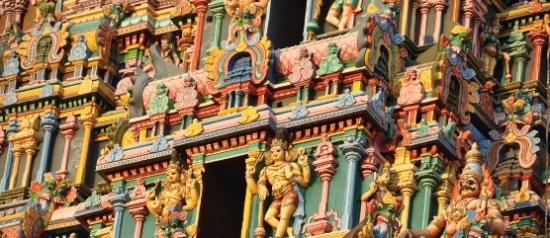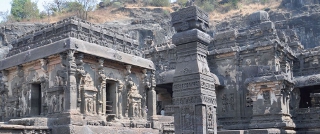
The roots of Hinduism date back as far as 2000 BCE, making it one of the oldest religions. It is also unique amongst other creeds in that it had no founder. It has always demonstrated a capacity to assimilate beliefs from other faiths, and this is probably one of the keys to its great success. There are many thousands of gods in the Hindu pantheon. Their one supreme deity has three physical manifestations: those of Brahma the creator, Vishnu the preserver and Shiva the destroyer. These represent the three basic processes of birth, life and death.
The earliest Hindu temples to have survived are located at Ellora which is situated approximately 500 km north-east of Mumbai (Fig 1). Beginning in the 6th century, talented craftsmen carved and sculpted monolithic temples from solid rock using unsophisticated tools. In this World Heritage Site, exquisite temples dedicated to Buddhism, Hinduism and Jain exist side by side.
Gradually, these temples became more elaborate. The Kailasa Temple at Ellora which is dedicated to Shiva is the most famous of this group (Fig 2). This building, the world’s largest monolithic structure, is 8l meters long, 47 meters wide and 33 meters high and is twice the area of the Parthenon in Athens. It was commissioned in the 8th century and 7000 workers labored for over 150 years to complete it.
Unlike all the other monoliths which were cut from ground level up, work on this temple was begun from the top of the rock, and the artisans chiseled, cut and carved on their way down. Huge blocks of rocks were left intact, from which the porch, pillars and other shrines were subsequently carved. Almost every area of this massive complex is sculptured, with friezes representing Shiva and episodes from the great Hindu epics, the Mahabharata and Ramayana along with mystical beings, nymphs, musicians and figures of good fortune and fertility.
The next stage of temple development was the creation of freestanding structural units. The best place to see this transition is in Mamallapuram (Mahabalipuram), situated on the shore of the Bay of Bengal 60km south of Chennai (Madras). By the first century this was a well established seaport visited by the ancient Greeks and Romans. It reached its apogee under the Pallava dynasty (600-800) who turned it into a major trading port. The name Mamallapuram means city of Malla, who was one of the great Pallava kings.
This World Heritage Site boasts some of the finest examples of Hindu art. These include freestanding temples known as Rathas (chariot-shaped temples). The Five Rathas in Mamallapuram comprise a group of 7th century freestanding pyramidal temples which are square or oblong in shape. Each temple has been chiseled from a single rock (Fig 3). They are adorned with elegant pillars and sculptured divinities. This impressive group of temples is guarded by three lifesize stone animals - a lion, an elephant and a bull. All of these well-proportioned temples remain unfinished.
Another innovation in Hindu Temple architecture can also be seen on the coast in Mamallapuram. The elegant sandstone Shore Temple with its slender towers and layered pagoda roof is one of the oldest temples in south India with some of the best examples of temple architecture (Fig 4). This finely carved temple was constructed in the 8th century. In what is quite an unusual feature, this temple houses two shrines; the larger one is dedicated to Shiva and the second one to Vishnu. The complex is surrounded by a row of guardian (Nandi) bulls carved from solid rock.
The Pallava dynasty also developed bas-relief sculptures. The most impressive one in Mamallapuram is carved on two huge adjacent rocks. The frieze is almost 30 meters long, attains a height of 9 meters and dates from about 600 CE. It is the largest bas-relief in the world (Fig 5).
In this vast stone frieze there are several hundred sculptured figures including deities from the Hindu pantheon, men, nymphs and half-celestial figures, as well as birds and animals. Each figure in itself is a separate work of act. Most impressive is the procession of elephants, one of which is five meters long. The emaciated figure standing on one leg represents Arjuna, one of the characters of the great Hindu epic, the Mahabharata. This statue gives the name to this unique bas-relief which is known as the Penance of Arjuna. It is believed that Arjuna is doing penance to the Hindu deity Shiva although the precise interpretation is not known with certainty. Some maintain that the relief represents the mythical descent of the holy Ganges River to earth.
Of interest is the fact that in both Mamallapuram as well as in Ellora, builders of these magnificent edifices left the sites for unknown reasons and their rich treasure of art and sculpture was forgotten for centuries.
Over the next thousand years, temples became more and more elaborate, with prominent gopurams (gatehouse towers) decorated with stucco figures as well as central shrines and multi-pillared spacious halls.
Hindu temple development culminated with the construction of the Meenakshi temple, one of the biggest temple complexes in India which is dedicated to Shiva and his consort Meenakshi, and was built in the early 1600’s (Fig 6). It is situated in Madurai and is one of the great architectural wonders of India, with its nine soaring gopurams decorated with thousands of colorful stucco images and statues of Hindu deities, other figures and animals. One of these gopurams attains a height of 60 meters.
This temple complex is a city within a city, with its teeming bazaar and constant hub of activity. One of the most dramatic structures in this complex is the Thousand Pillar Hall, with its 985 superbly carved pillars.
Hindu temples have survived the rigors and ravages of time. There is much hidden wealth in some Hindu temples and throughout Indian history they were frequently looted by foreign invaders. The Portuguese traveller, Vasco Da Gama, sailed back with ships full of gold plundered from the temples. Recently, hidden wealth valued at more than $20 billion was found in a temple in Kerala, one of the states in South West India. This was probably transferred by the local ruler into secret chambers in the temple to prevent it from getting into the hands of the British.
The focal point of a Hindu temple is its sanctuary, the home of its deity. In the larger temples, a series of successive buildings allow the worshiper to move towards the final encounter with the god in the inner sanctuary. In contrast to the profusion of color and life on the outside, the interior is dark and often cramped, but here it is believed lies the center of the deity’s power.
The Hindu faithful are little interested in art and pay scant attention to the external sculptures and paintings of the temples, however sublime they may be. To them, the form is hardly important. They venerate a deity whether it be a famous statute or nothing more than a simple image made on a piece of wood.
Shore Temple


Kailasa Temple
 Let’s have a bit of Playback
Let’s have a bit of Playback-1372659501.jpg) Buying New Construction in Israel
Buying New Construction in Israel A lot of hot air - ballooning
A lot of hot air - ballooning A School Centenary
A School Centenary Train Trips
Train Trips-1451900978.jpg) The Agunah- The Deserted Wife
The Agunah- The Deserted Wife Irving Spitz
Irving Spitz